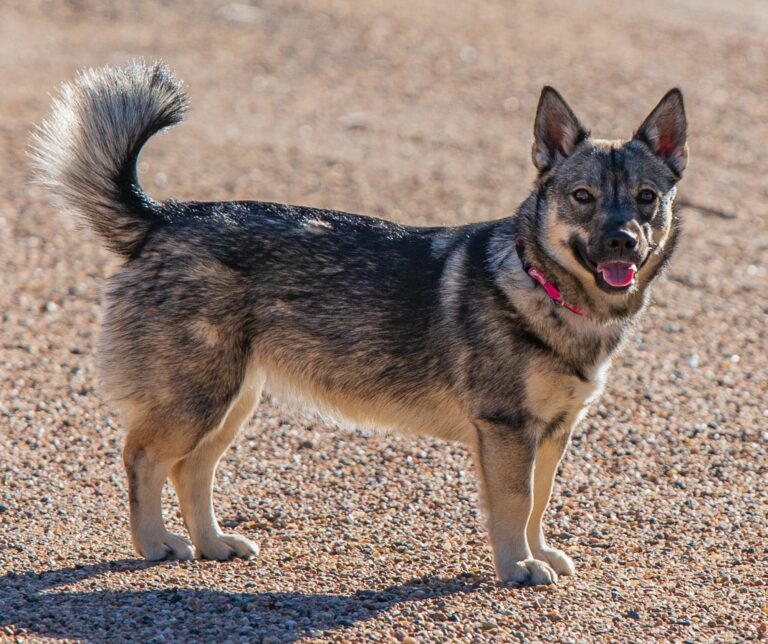Swedish Vallhund Dog Breed
The Swedish Vallhund, known as the ‘Viking Dog,’ is a herding breed valued for its intelligence and friendly nature. This breed looks like a wolf and is muscular, making it an excellent farm worker for managing cattle and sheep.
Rooted in Viking history, the Swedish Vallhund is now a versatile dog that can serve as a loyal guardian or excel in various dog sports. These dogs have complex behaviors and unique needs that owners should understand.
The Swedish Vallhund’s historical background still influences its abilities and how we care for them today.
Key Takeaways
- The Swedish Vallhund excels in herding and dog sports.
- Originally bred by Vikings, this breed is a versatile companion.
- Owners should learn about their companions and needs.
Quick Facts
The Swedish Vallhund is a sturdy, medium-sized dog from the Herding Group, known for its robust build and long body. Male Vallhunds stand about 12.5 to 13.75 inches tall, while females are slightly shorter at 11.5 to 12.75 inches. They typically weigh between 20 to 35 pounds. These dogs, often called Swedish Cattle Dogs, have an average lifespan of 12 to 15 years and are celebrated for their historical connection to Vikings, serving as loyal herders and companions.
With its thick fur, the Swedish Vallhund is well-suited for cold climates and is full of energy for its herding duties. Their shorter legs can make it challenging to move in deep snow, but they have strong instincts for herding animals. Health-wise, their pointed ears might make them more prone to ear problems, but this is not very common.
These dogs are also intelligent and quick learners, making them great for dog sports and activities beyond herding.
Swedish Vallhund Dog Breed Pictures
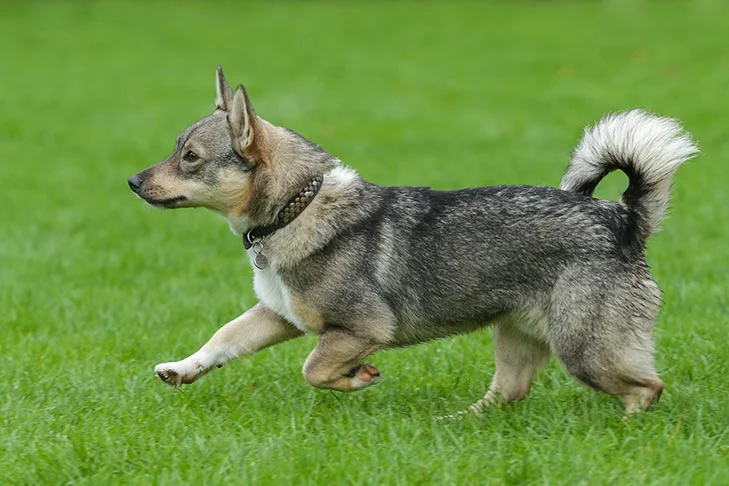
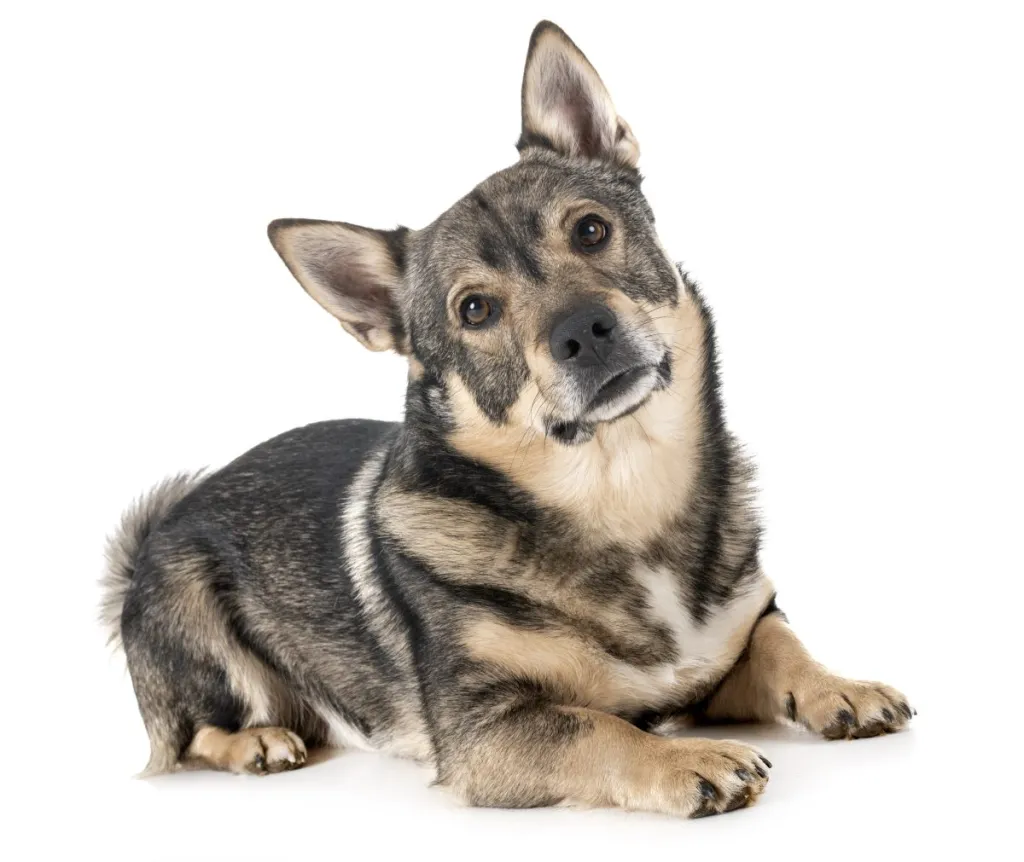
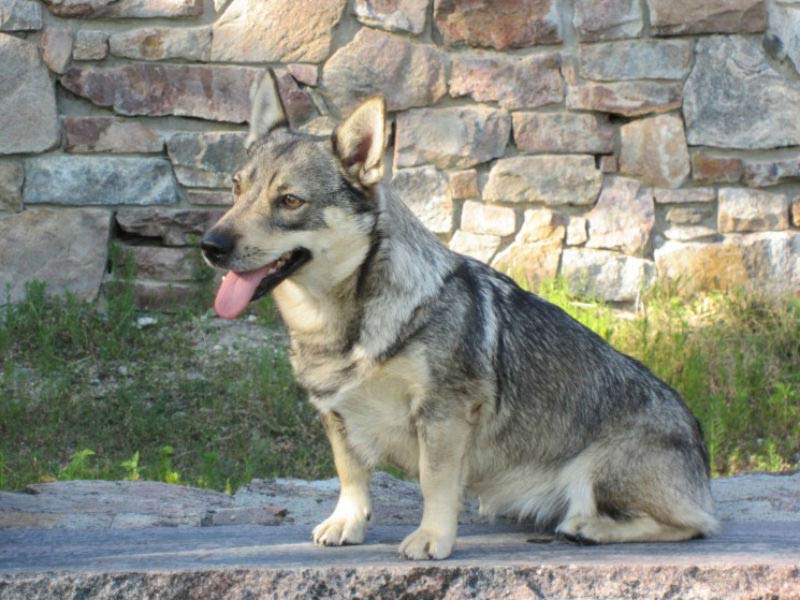
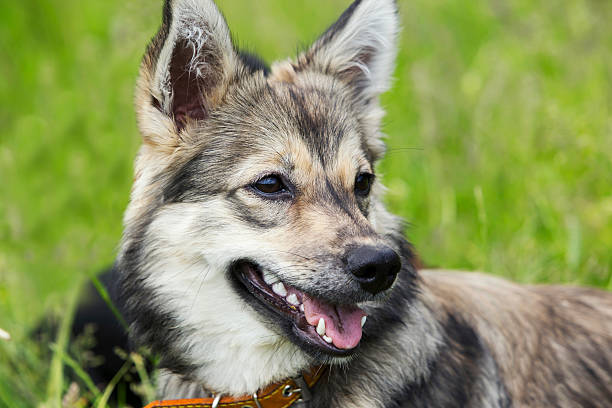
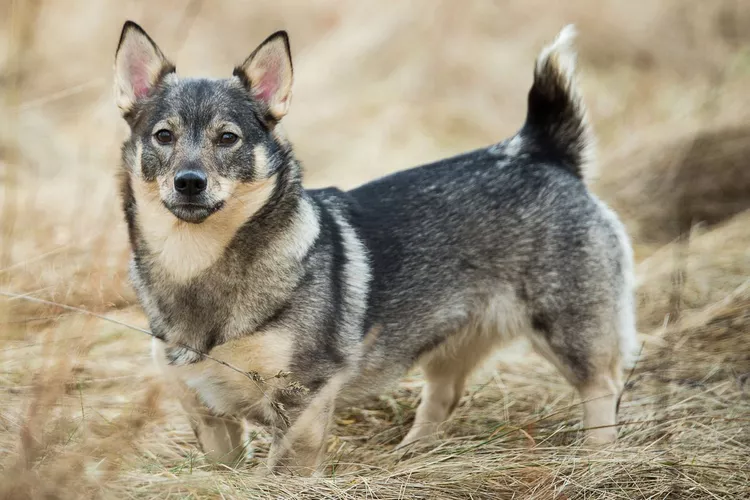
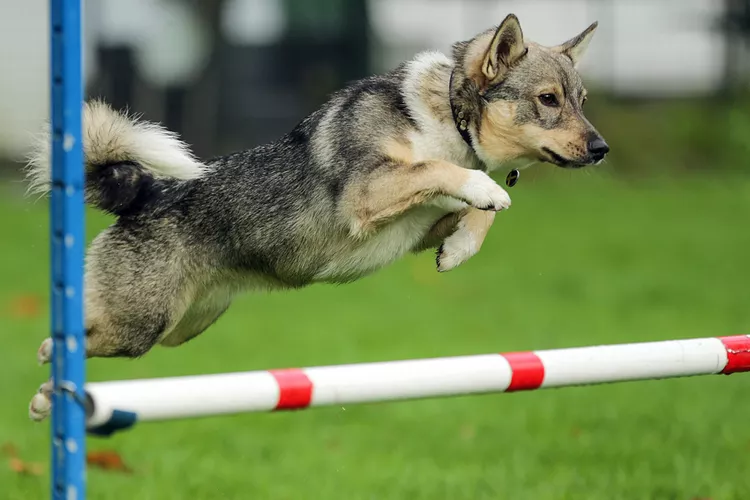
Swedish Vallhunds Overview
The Swedish Vallhund is an impressive example of an innovative and adaptable dog, especially among herding dogs. This breed has a body built for the challenging task of managing livestock. Its short legs and muscular build let it move quickly and tirelessly, which is crucial for any dog tasked with herding.
These dogs have a thick coat to keep them warm in cold weather, a nod to their roots in the cold regions of Sweden. They tend to live long lives, generally between 12 to 15 years, showing they’re tough. It’s worth noting that those distinctive pointy ears might need extra attention to avoid ear problems.
Regarding brainpower, the Swedish Vallhund is bright and always on the alert. This makes it great for making quick decisions when it’s out there working with sheep or cows. But their smarts can sometimes lead to them trying to outwit their owners, so you’ve got to stay on your toes with dog training. They also need plenty of things to do to keep from getting bored, and they’re great at dog sports like obedience and agility, where they can show off their skills.
People considering getting a Swedish Vallhund should know these dogs can be pretty protective of their space. They also shed a lot, so be ready for some regular grooming.
Vallhund Temperament Summary
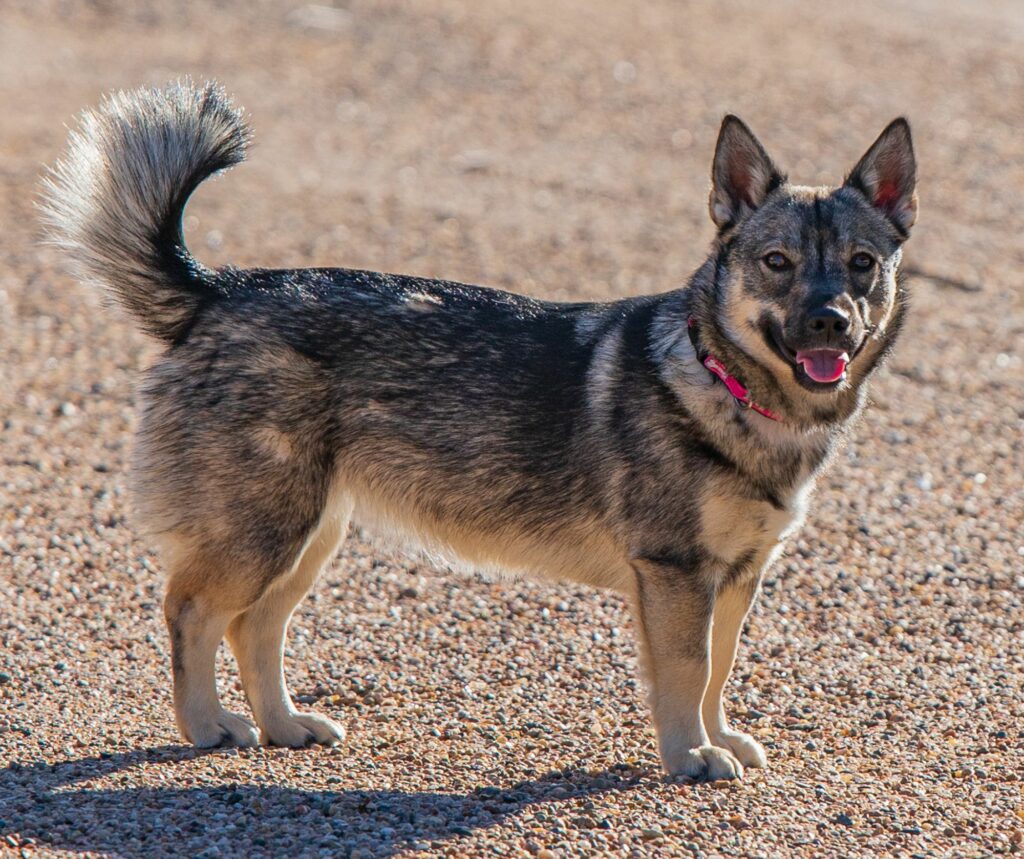
Swedish Vallhunds are known for their alertness and energy, which make them excellent watchdogs and lively pets. These herding dogs are small but mighty, showing a great mix of focus and fun that suits active owners or families well. They have a habit of barking, which is part of their herding heritage, and they use it to communicate and make their presence known.
These dogs are eager to learn and need activities that keep them busy. They do best with an owner who can offer firm guidance and consistent training. Swedish Vallhunds have a strong herding instinct and might try to herd other animals or people. This can involve nudging or gentle nips, so it’s important to guide this behavior correctly.
Here’s a rundown of the Vallhund’s temperament:
| Trait | Description |
|---|---|
| Alertness | Always on the lookout, making them great for keeping watch. |
| Energy | Full of life and need regular exercise and mental challenges. |
| Intelligence | They pick up on training quickly and can think for themselves. |
| Social Skills | They’re friendly and well-mannered but must be taught to behave around new animals. |
For a rewarding relationship with a Swedish Vallhund, it’s crucial to understand and meet their temperament needs.
Viking Age Origins and Lifespan
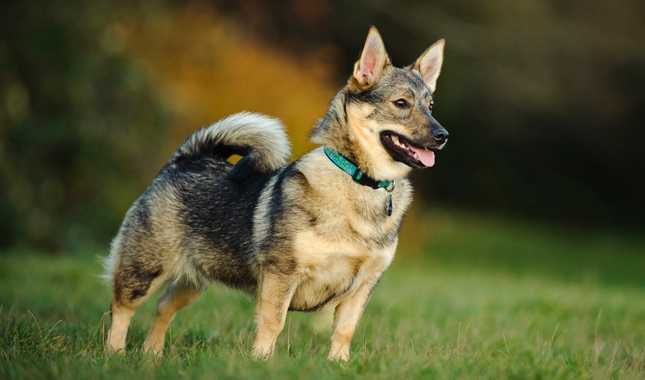
The Swedish Vallhund, deeply rooted in the Viking Age, offers a unique look into the lives of the Norse people. These dogs played a crucial role in the Vikings’ life, from herding livestock to protecting their owners. Today, they are celebrated for their versatility and efforts to ensure they remain part of Scandinavian heritage.
The Vallhund’s silhouette, which echoes Norse art, transports us back to the time of Viking explorers. Their endurance and versatility in the cold Scandinavian climate are admired. The breed almost disappeared but was brought back by dedicated dog lovers, showing a deep appreciation for historical breeds.
Kennel clubs worldwide now recognize the Vallhund, proving its broad appeal and the strong connection humans have always had with their dogs.
Ancient Nordic Breeds
The Swedish Vallhund and other ancient Nordic breeds have a history dating back to the Viking Age. These dogs were essential to Viking daily life, serving as herders and trusted companions. Their physical features, like pricked ears, dense coats, and a wedge-shaped head, showcase their heritage.
The Swedish Vallhund, often compared to the Welsh Corgi, is believed to be a descendant of these old Nordic breeds, showing how their genes have persisted through time. These dogs have shaped not only their own breed’s evolution but also the development of other dog breeds today.
Vallhund Historical Roles
Rooted in their Nordic past, Swedish Vallhunds date back to the Viking era, where they excelled as versatile work dogs within farming communities. These sturdy dogs played a vital role in the Vikings’ economy, far beyond their duties as herders. They were adept at navigating the harsh Scandinavian landscapes, their small size making them perfect for managing and moving livestock.
The Vallhund was a vital part of the farm’s life, skilled in protecting and herding animals. Their ability to ward off wild animals and gather cattle and sheep was invaluable. These historical roles demonstrate Vallhund’s natural talents as a breed developed for hard work and practicality in rural life.
Breed Preservation Efforts
In the early 1900s, the Swedish Vallhund, a breed with roots in the Viking Age, was on the brink of disappearing. Count Björn von Rosen of Sweden took action to save these dogs, recognizing their unique heritage and genetic value.
He worked with the Swedish Kennel Club and American Kennel Club to find the few remaining Vallhunds and breed them carefully. This careful breeding and record-keeping helped bring the breed back from the edge of extinction.
Thanks to these efforts, the Swedish Vallhund could continue as a breed, preserving its historical importance and genetic diversity.
Compact Stature Overview
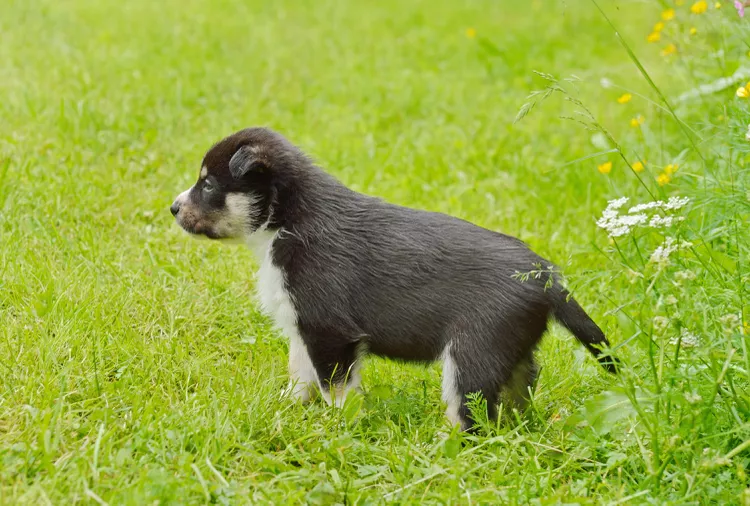
The Swedish Vallhund’s more petite build isn’t just a notable feature; it’s also crucial to its success as a versatile herding dog. Owners should consider how the breed’s size influences living space needs, health, and exercise routines. A detailed look at these factors shows how well the Vallhund can do in different settings and stresses the need for appropriate care to maintain its health and happiness.
Breed Size and Abilities: Their compact shape contributes to their agility and stamina.
Ideal Home Environments: The right setting can promote both mental satisfaction and physical well-being.
Adaptation Skills: Vallhund’s genetics allow it to handle various weather conditions easily.
Health Considerations: Their size is linked to specific inherited health issues that owners should monitor.
The Swedish Vallhund’s smaller size greatly benefits its agility and endurance. Such a build allows these dogs to excel in activities that require quick movements and lasting energy. A home environment providing mental stimulation and exercise space is ideal for Vallhunds. This could be a house with a yard or near a park where they can stay active and entertained.
Their genetic makeup makes them well-suited for different climates, from chilly northern areas to more temperate zones. However, like all breeds, Vallhunds have specific health risks tied to their stature. Being aware of these can help owners prevent and manage potential issues. Providing a nurturing environment tailored to their physical and psychological needs is essential in caring for a Vallhund.
Breed Size Characteristics
Swedish Vallhunds are a sturdy herding breed packed into a small frame, standing at most 13.75 inches tall and weighing up to 35 pounds. These dogs boast a long body that sets them apart from other small breeds, echoing their Viking roots. Their dense coat ranges from grey to red, enveloping a robust body.
The breed’s wedge-shaped head, dark brown eyes, and erect ears give them a vigilant look but also mean they can be prone to uncommon ear issues.
Due to their short stature, Swedish Vallhunds might struggle to move through heavy snow. However, they are long-lived for canines, often reaching 12-15 years with proper care. Swedish Vallhunds need regular mental stimulation and physical exercise to stay healthy and happy.
Ideal Living Spaces
The Swedish Vallhund is ideally suited for apartment life due to its small dog size and adaptability. These dogs have a distinctive body shape that’s long and low, allowing them to move quickly in confined spaces. They are agile and have moderate energy, which aligns well with the hustle and bustle of city living flyball.
Swedish Vallhunds owners must ensure their pets get regular exercise and mental challenges to stay healthy. This means taking them out for daily walks and engaging in play that stimulates their intelligent minds. Social interaction is crucial, too – it helps these dogs remain happy and well-behaved at home.
Physical Adaptability
Swedish Vallhunds have a well-suited build for adapting to various living situations. Their compact and sturdy shape, short legs, and long bodies give them a low center of gravity. This makes them stable and agile, vital for herding livestock.
These dogs may be small, but they’re tough and can thrive just as well in a cozy city apartment as in a spacious countryside setting.
Their body structure also supports reasonable temperature control, thanks to their medium-length double coat that keeps them insulated in different weather. This adaptability of the Swedish Vallhund to both hot and cold climates showcases their versatility.
Health Implications
Swedish Vallhunds are generally healthy and tend to live long lives, but they do have specific health issues that owners should watch out for. Their unique body shape, long torso, and short legs can make them prone to particular conditions.
Regular vet visits and eye exams are vital because they can develop progressive retinal atrophy, an eye condition that may cause blindness if not caught early.
The Vallhund’s short legs aren’t ideal for deep snow, so owners should be cautious during winter. To keep these dogs healthy in all weather, provide plenty of shade and water when it’s hot to prevent overheating.
Regular veterinary care and preventive measures are vital to keeping Swedish Vallhunds and Spitz in shape.
Exercise Needs
Regular physical activity and mental challenges are crucial for the well-being of a Swedish Vallhund. Daily walks and stimulating games are necessary—hiking, herding, and agility training help maintain muscle health.
To prevent boredom and related issues, including obedience training and games that make them think. This also helps them get along with others, which is essential due to their sometimes bossy nature with new animals.
Balancing their physical and mental activities is critical to keeping them happy and social.
Watchdog Vallhund Character Traits
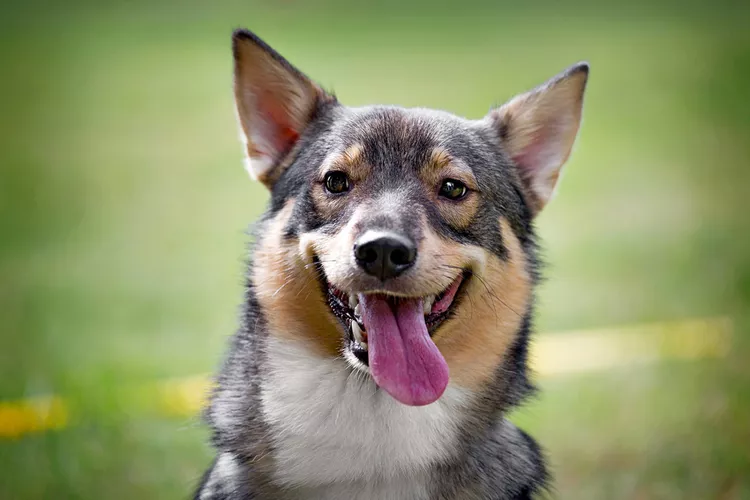
The Swedish Vallhund is a breed full of life and always alert, showcasing a spectrum of traits that make it stand out. These traits are crucial to the dog’s essence and greatly influence how they learn, interact, and are looked after. Getting to grips with these traits is essential to ensure a good relationship between the Vallhund and its owner.
Smart and Easy to Train: The Vallhund is known for its sharp mind and learning capacity, making it a joy to train. This breed loves a good challenge and excels at picking up new commands and tricks.
Devoted and Friendly: These dogs develop solid and lasting connections with their families, leading to deep loyalty and warmth. They thrive on companionship and enjoy being part of the family unit.
Energetic and Lively: Vallhunds possess a zest for life and require regular exercise to stay happy. This makes them perfect for people who lead an active lifestyle and enjoy having a dog that can keep up.
Instinctive Behavior: With a strong herding background, Swedish Vallhunds have a built-in desire to herd, which can be seen in their daily behavior. This instinct gives them a sense of purpose and can be channeled into various dog sports or activities.
Personality Traits
Swedish Vallhunds are known for their alert and spirited nature, making them excellent watchdogs. They are highly trainable and enjoy having fun. These dogs are brilliant and learn commands quickly, especially when trained by someone clear and firm.
They love to be mentally stimulated and are happiest when they have tasks that keep them mentally and physically active. Vallhunds are also great with kids, showing a warm and friendly side that makes them good family pets. However, they can be stubborn and push boundaries, so training them with a robust and respectful approach is essential to get the best results.
Social Behavior
Swedish Vallhunds are known for their intelligence and vigilance, making them exceptional as protective guards and affectionate family pets.
Their herding solid instinct is evident as they may try to control where people and other pets go, sometimes even using a gentle poke or nip to guide them. Introducing them to different animals early on is essential to prevent aggressive behavior towards unfamiliar dogs.
Being active family members, they enjoy both physical exercise and mental challenges, such as participating in obedience or agility training.
A confident pet parent who can set firm rules and use positive methods to encourage good behavior will effectively guide their social growth.
Trainability Compatibility
Swedish Vallhunds are naturally good at learning and excel in obedience and agility training. Their eagerness to work and vibrant energy make them quick learners and willing participants in training exercises. They grasp new commands swiftly, showing off their sharp minds. These dogs need challenging tasks to keep their brains active and prevent boredom.
Proper socialization is critical, as it helps to balance their natural leadership qualities and ensures they play well with others. Engaging in structured activities like obedience classes is crucial for the well-rounded growth of a Swedish Vallhund.
Energy Levels
Swedish Vallhunds puppy are known for their boundless energy and need a lifestyle with plenty of exercise and brain games. These herding dogs thrive when busy and can become arduous if they’re not given enough to do. They’re at their best when involved in dog sports like agility or obedience, which work out their bodies and minds.
Regular and planned activities help prevent destructive behaviors from boredom, such as being too controlling or picking fights with other pets. Introducing them to different people and animals is crucial to ensure they get along well with everyone.
Swedish Vallhunds should be given consistent opportunities to run, play, and think to keep their lively spirits in check. Such engagement will help them remain happy and well-behaved companions. Engaging them in tasks they were bred for, like herding, can also be particularly rewarding for them. Proper socialization from a young age ensures that their high energy translates into positive experiences with others.
Instinctual Behaviors
Swedish Vallhunds are naturally alert and have a strong instinct to herd, owing to their background as cattle herding dogs. Their sharpness and quick decision-making were essential for managing livestock. Even today, these dogs may try to organize their surroundings, including herding other pets or nudging people’s heels.
Proper training can redirect these instincts into organized activities like herding trials, where Swedish Vallhunds can demonstrate their skills in a controlled setting.
Training these dogs positively directs their natural behaviors and keeps their minds active and engaged. Participating in herding activities allows Swedish Vallhunds to fulfill their instinctual desires productively and enjoyably for them and their owners.
Genetic Health Concerns
Swedish Vallhunds, known for their vitality, can still inherit specific health issues that may affect their well-being. Ensuring breeders and dog owners keep up with health checks is vital to catch and treat these conditions early. Early intervention and proper care can significantly improve the life of a Vallhund with these health problems.
Loss of sight due to Progressive Retinal Atrophy (PRA) can change how a dog interacts with the world around it. Hip Dysplasia is another condition that can cause ongoing pain, significantly impairing a dog’s ability to move and enjoy life. Patellar Luxation might lead to sporadic or persistent lameness, taking away from the breed’s natural love for activity. When a Vallhund develops Cataracts, their vision becomes cloudy, which can cause distress and confusion for the animal.
For the best outcomes, owners should work closely with their vets to manage these health challenges. Regular check-ups and preventive care are vital to helping these dogs live whole, happy lives.
Inherited Health Conditions
The Swedish Vallhund, known for its overall good health, can still face inherited health issues that owners and breeders must watch out for. These dogs might have a higher chance of developing ear-related problems because of their pointy ears, so regular ear checks are a good idea.
They can cope with hot weather if they stay hydrated and have shade, but their short legs might struggle in deep snow.
It’s essential for anyone thinking of getting a Swedish Vallhund to understand the breed’s health risks, maintain regular vet visits, and follow a plan to prevent health problems. It’s also wise to get these dogs from responsible breeders who test for genetic conditions to help keep the breed healthy for years.
Routine Health Screenings
Routine health screenings are essential for the Swedish Vallhund. This dog breed has a higher risk of specific genetic issues, so keeping a close watch on their health is critical. Eye exams are essential to detect progressive retinal atrophy (PRA) before it leads to permanent vision loss. Genetic tests can predict the likelihood of degenerative myelopathy, a severe disease that affects the spinal cord. Regular thyroid checks are necessary to spot any hormonal imbalances quickly. Regular dental check-ups are also vital due to the breed’s tendency for dental problems.
We are emphasizing the need for thorough health monitoring for these dogs.
Managing Genetic Disorders
Keeping Swedish Vallhunds healthy requires a strong focus on regular health check-ups and preventative care. Ensuring these dogs live a long, typically 12 to 15 years, involves owners consistently checking their ears to prevent issues their pointy ears might face. Regular physical activity and mental challenges are vital in avoiding behavioral problems and maintaining the dog’s health. Regular vet visits are essential for catching and treating any genetic issues early. Ethical breeding is also crucial, with breeders needing detailed health screenings to reduce the chance of hereditary diseases being passed on, keeping the breed’s future healthy.
Owners of Swedish Vallhunds should prioritize health maintenance and preventive veterinary practices. To ensure these dogs enjoy their average lifespan of 12 to 15 years, they must regularly check their distinctive pointy ears for any problems. Including daily exercise and mental stimulation can prevent behavioral issues and improve the dog’s quality of life. Frequent veterinary check-ups are essential to spot and manage any genetic problems early. Responsible breeding practices, including comprehensive health tests, are critical to decreasing the likelihood of hereditary conditions in Swedish Vallhunds.
Grooming Essentials
Caring for a Swedish Vallhund’s coat keeps them looking and feeling their best. It’s important to know what this particular breed needs to stay healthy. Here’s a simple guide to keeping your Vallhund in top shape:
- Brush their coat weekly. This helps control shedding and keeps their fur shiny. Use a good quality brush that reaches their undercoat to remove loose hairs effectively.
- Please bathe them monthly using shampoos made for dogs. This will help protect their skin and keep their coat in good condition. Be sure to rinse well to avoid any residue irritating their skin.
- Don’t forget about their teeth. Regular brushing prevents tartar build-up and gum disease. Use toothpaste designed for dogs and a suitable toothbrush for their size.
- Keep their nails trimmed to prevent pain while walking. If you hear their nails clicking on the floor, it’s time for a trim. A good pair of dog nail clippers will make the job easier.
These steps are more than just about grooming; they’re about maintaining your dog’s health and happiness. A well-groomed Vallhund is a happy Vallhund.
Coat Maintenance Routine
Proper grooming is vital for the Swedish Vallhund’s double coat to stay healthy and look its best. Brush the coat at least twice weekly using a slicker brush and a metal comb. The slicker brush works well to untangle and clear out dead hair from the top layer. Meanwhile, the metal comb gets through the thick undercoat, preventing hair from matting and tangling. Only bathe your dog when necessary using dog-specific shampoos to avoid skin irritation.
Taking care of your dog goes beyond just brushing their fur. You should also regularly clean their ears, clip their nails, and maintain their dental health to prevent common health issues. If you’re not confident performing these tasks, consider hiring a professional groomer. They have the skills and experience to handle these grooming needs safely.
Brushing Frequency
Regular grooming is vital to keeping their coat in top condition for the Swedish Vallhund. Brushing their coat at least two to three times a week is recommended to avoid tangles and manage loose hair. Using a slicker brush and a metal comb is the best way to care for Vallhund’s distinctive double coat. Pay extra attention to areas with white fur, as they can show dirt and shed hair more obviously.
During shedding seasons, increasing the number of brushing sessions can help keep your home hair-free. Using a detangling spray or a conditioning mist can make brushing smoother and more comfortable for your dog. This approach to grooming ensures that your Swedish Vallhund’s coat stays healthy and looks great.
Bathing Recommendations
Keeping your Swedish Vallhund clean is essential for their health and involves bathing them every 6 to 8 weeks. It’s best to use a mild dog shampoo to avoid stripping their coat of its natural oils. This routine is critical to prevent their thick fur from trapping dirt and causing skin issues. Choosing the right shampoo is crucial as it needs to be cleaned without harming the skin’s protective layers.
After a bath, it’s essential to thoroughly dry their coat to prevent skin problems and fur tangling. Pay extra attention to their ears when drying to avoid moisture-related infections. Regular brushing should be part of your dog’s grooming to keep their coat in top condition.
Nail Care Tips
Keeping nails trimmed is a vital part of caring for a Swedish Vallhund, helping to keep their paws in good shape and prevent issues with walking due to long nails. Using nail clippers designed for dogs to get a clean cut and reduce the chance of hurting your pet is essential. Be careful to steer clear of the quick, sensitive blood vessels in the nail because cutting it can cause bleeding and pain for the dog.
If you’re not confident in trimming nails, asking a groomer or vet to show you how is a good idea. They can teach you the correct way to do it and help you avoid harming your Vallhund.
After trimming, give your dog some treats and praise them. This helps your Vallhund associate nail trimming with positive experiences, making it easier for both of you next time.
Seasonal Shedding Management
Caring for a Swedish Vallhund means staying on top of their heavy shedding. Regular grooming is crucial, especially when their thick double coat starts to drop more hair. Using a de-shedding tool that’s top quality will help you keep your home free of hair. When shedding is at its peak, you should brush your dog more often. This prevents their fur from tangling and stops too much hair from spreading around your house.
Keeping your Vallhund healthy with a balanced diet and plenty of water can reduce shedding. If you need advice, a groomer who knows the breed can suggest the proper grooming techniques and products. They can help you keep your dog’s coat in good shape all year round.
Dietary Recommendations
The Swedish Vallhund is a sturdy, lively dog breed that thrives on a well-thought-out diet to stay healthy and energetic. Crafting a meal plan that offers balanced nutrition for these active dogs is critical.
For the health and longevity of the Swedish Vallhund, consider these updated dietary guidelines:
- Choose a diet high in animal proteins and fats essential for their strong muscles and energy levels.
- Tailor their meals to their metabolic needs to help avoid weight gain and related health issues.
- Pick dog foods that don’t contain unnecessary fillers or artificial ingredients to reduce the likelihood of allergies and stomach problems.
- Include omega fatty acids and antioxidants in their diet to support a shiny coat, smooth skin, and a robust immune system.
When selecting food for your Swedish Vallhund, looking for specific products known for their quality ingredients is beneficial. For instance, brands like Orijen and Acana offer grain-free options with various protein sources suitable for this breed.
Always consult your veterinarian to tailor your dog’s diet to their health needs.
Balanced Nutrition Essentials
Proper nutrition is essential for the Swedish Vallhund. They need a diet with plenty of proteins, healthy fats, and carbohydrates. These nutrients support their active lifestyle and contribute to their general health.
When picking the right food, you should focus on a balanced diet that meets the breed’s unique needs. This might mean choosing foods for small breeds or those designed for active dogs.
Controlling how much your Swedish Vallhund eats is critical to avoid weight gain, which they’re prone to. Adjust their food portions based on how much they exercise and their age.
Adding safe, fresh fruits and veggies to their meals can be beneficial. It’s also a good idea to check in with your vet regularly. They can tailor the diet to your dog’s health needs and ensure the nutrition plan is right for them.
Managing Weight & Health
Monitoring portion sizes is crucial for keeping a Swedish Vallhund at a healthy weight; diet quality matters for these dogs, which should weigh between 20 and 35 pounds. They need a balanced diet with lean protein, good fats, and complex carbs suited to their activity levels and health needs. When they’re active, like during obedience training, they may need more specific nutrition.
Treats must be given in moderation to prevent extra calories that could upset their diet. Regular exercise is essential to keep their muscles strong and to avoid obesity. Regular vet check-ups help keep track of their health and adjust their diet as needed.
Suitable Food Choices
When creating a diet for a Swedish Vallhund, focus on high-quality proteins, essential fats, and complex carbohydrates. These nutrients are vital for their high energy levels and muscle maintenance. This breed, which has a history of herding, requires a diet that suits medium-sized, active dogs.
Protein is vital for maintaining their athletic build, while healthy fats help to keep their energy up and coat shiny. Complex carbohydrates are necessary to keep their active bodies fueled throughout the day.
Watching the portion sizes to prevent weight gain is essential, which can put extra stress on their joints. Look for dog food that caters to medium-sized breeds’ specific needs to ensure your Vallhund gets what they need. This can also help manage any food sensitivities they might have.
Consult a vet to tailor the diet to your dog’s health needs.

